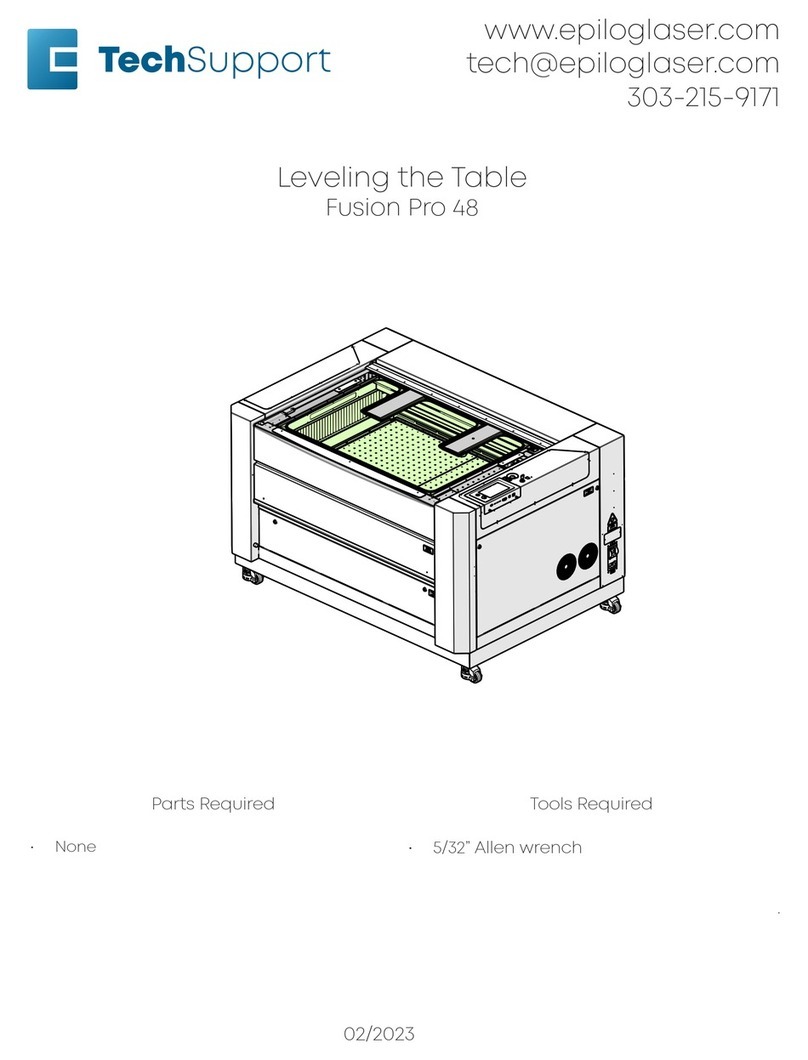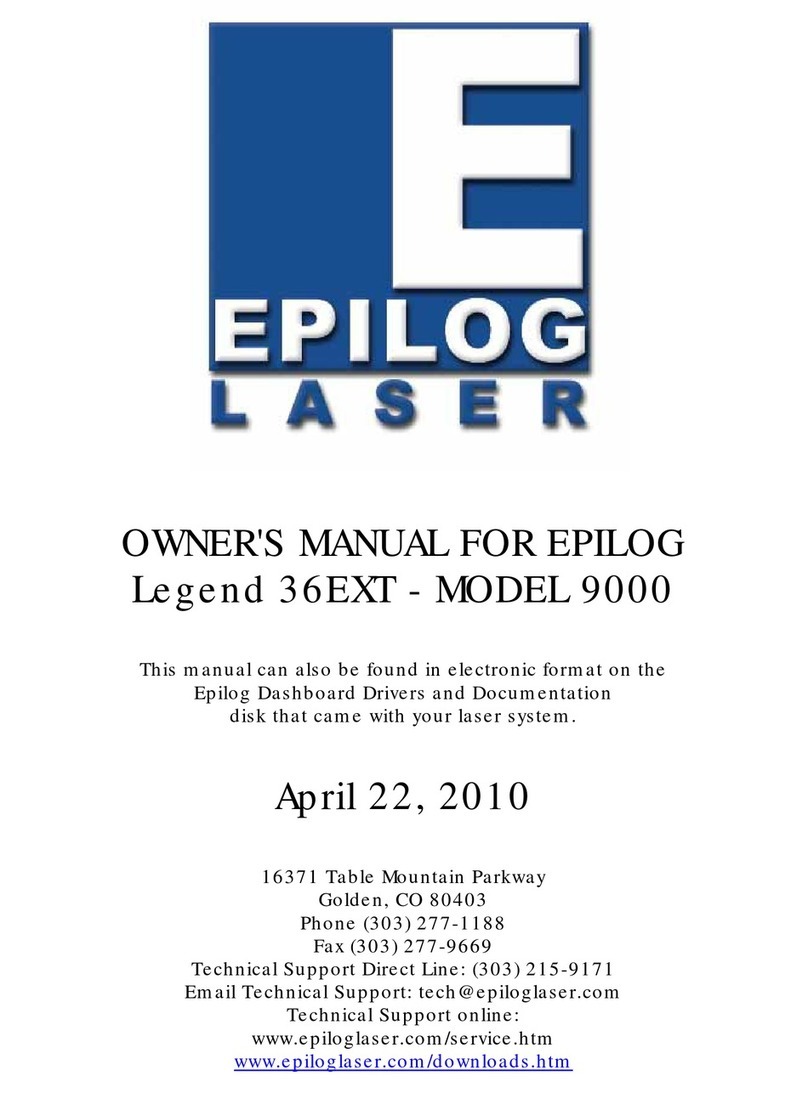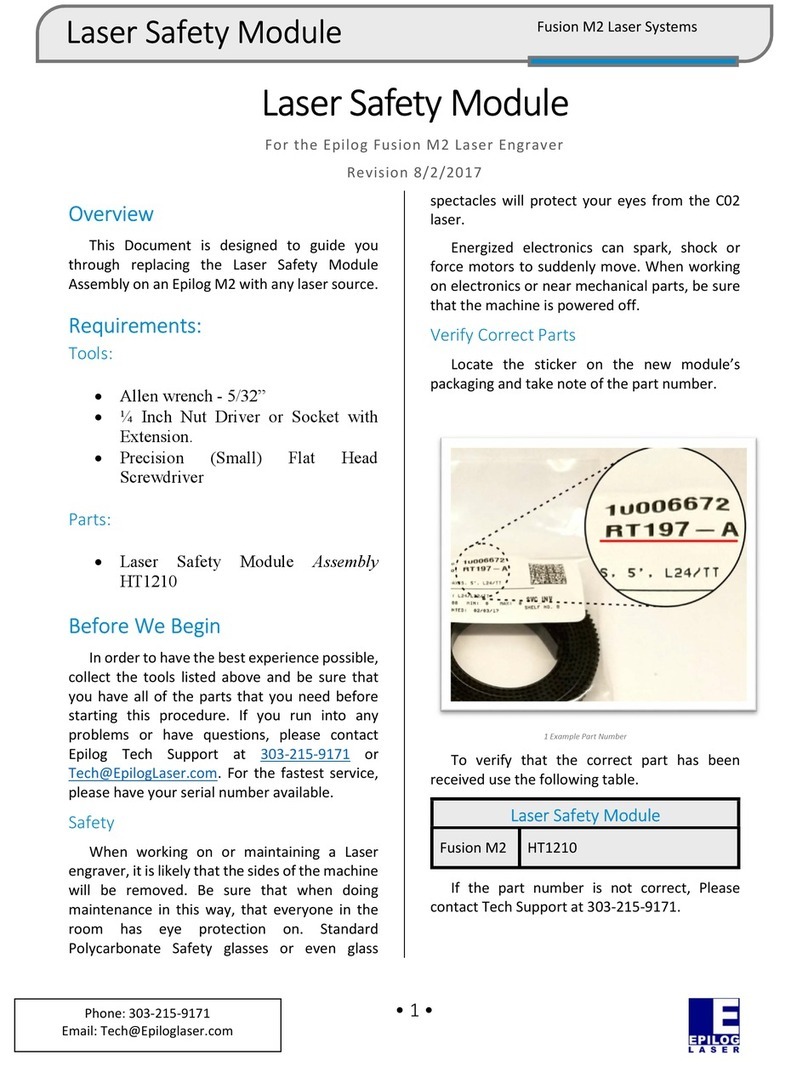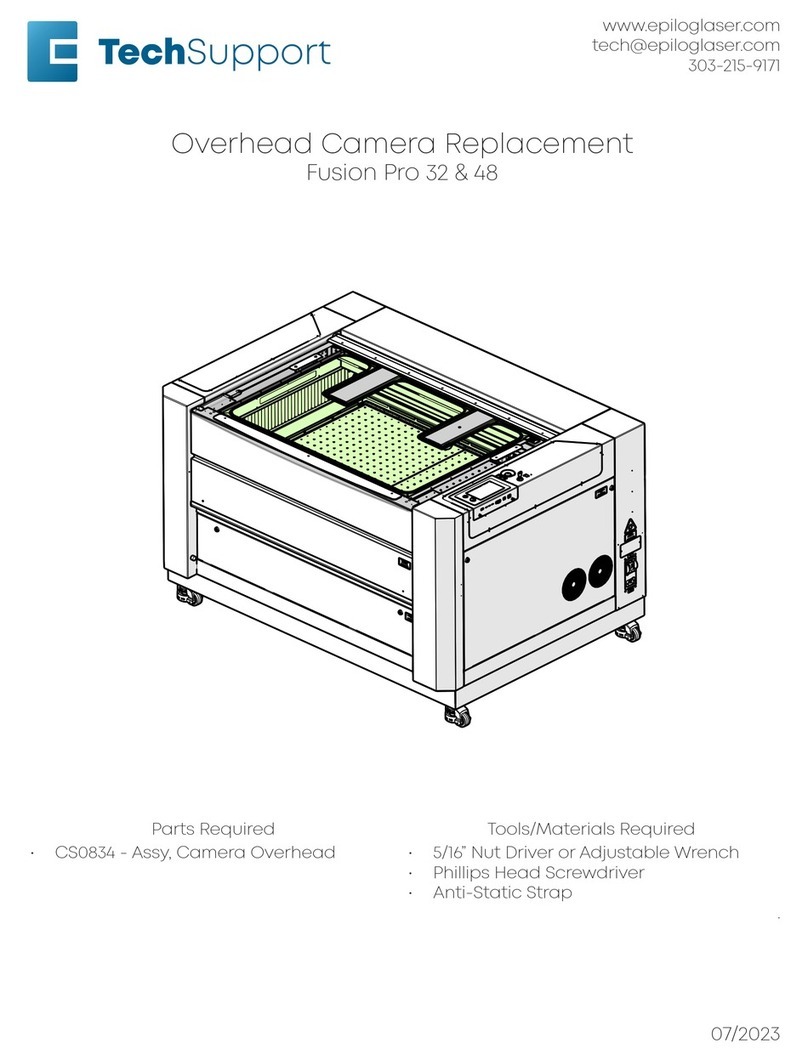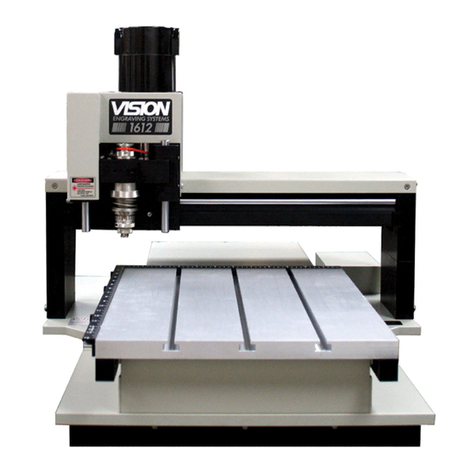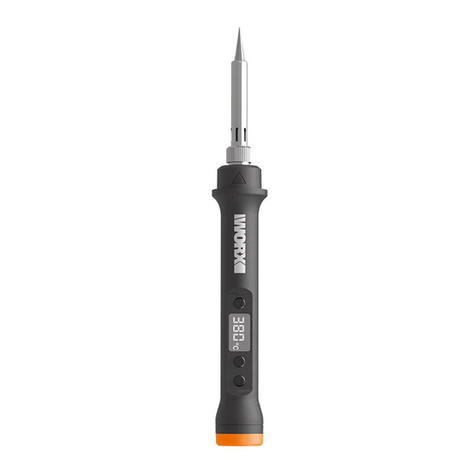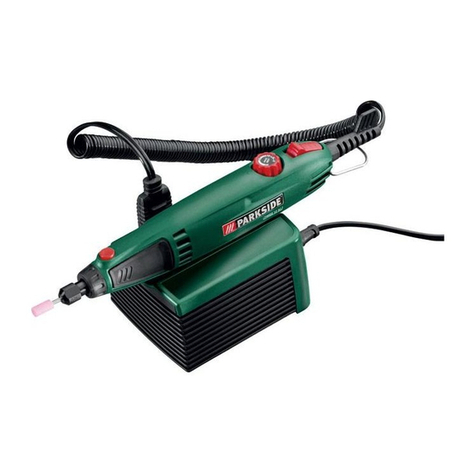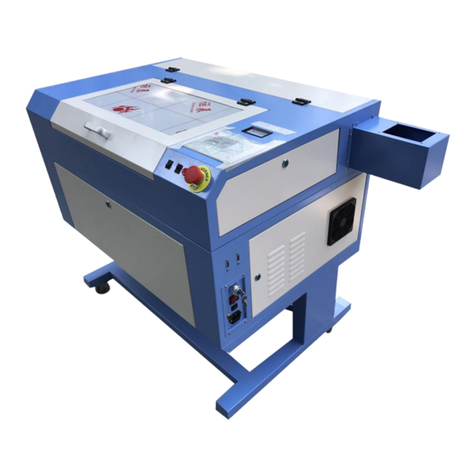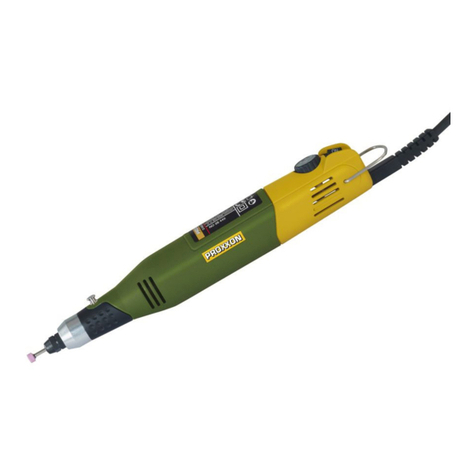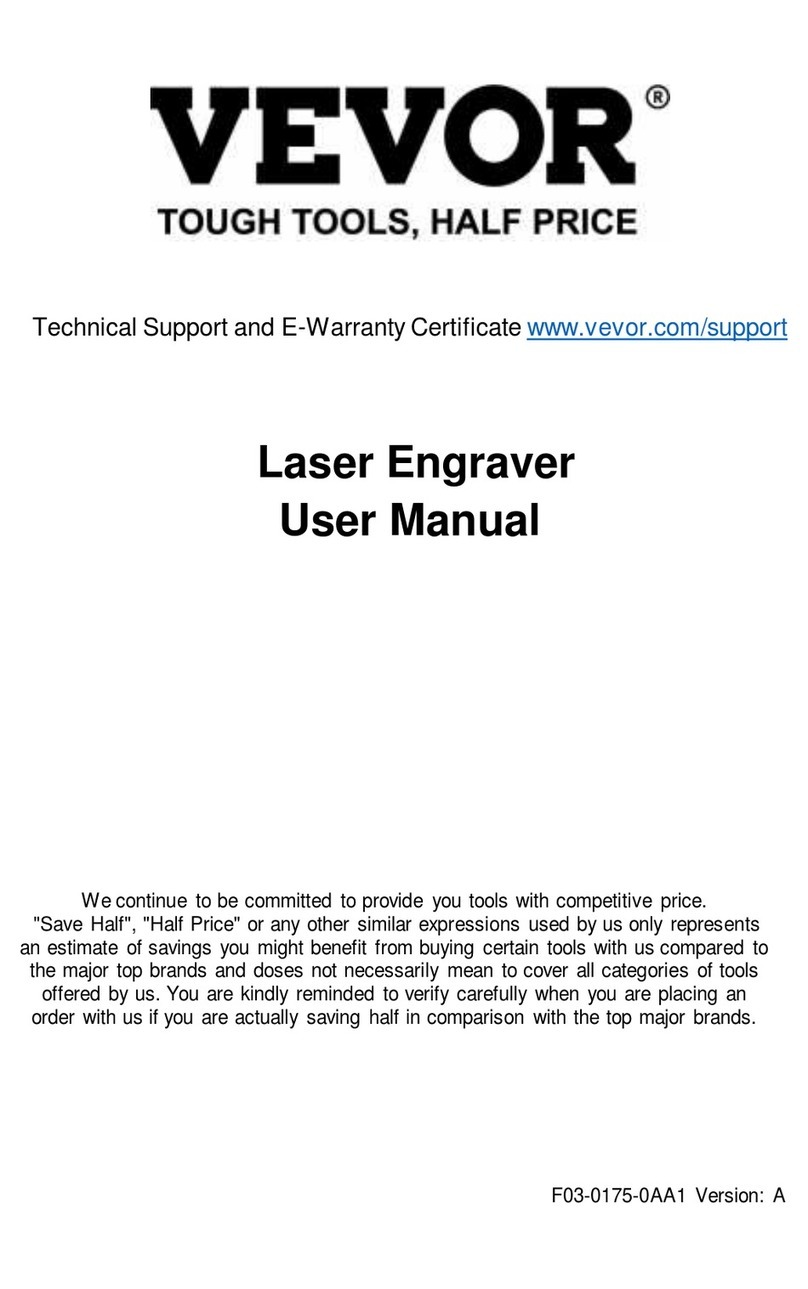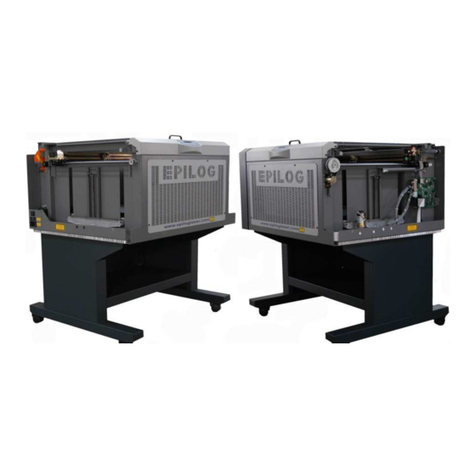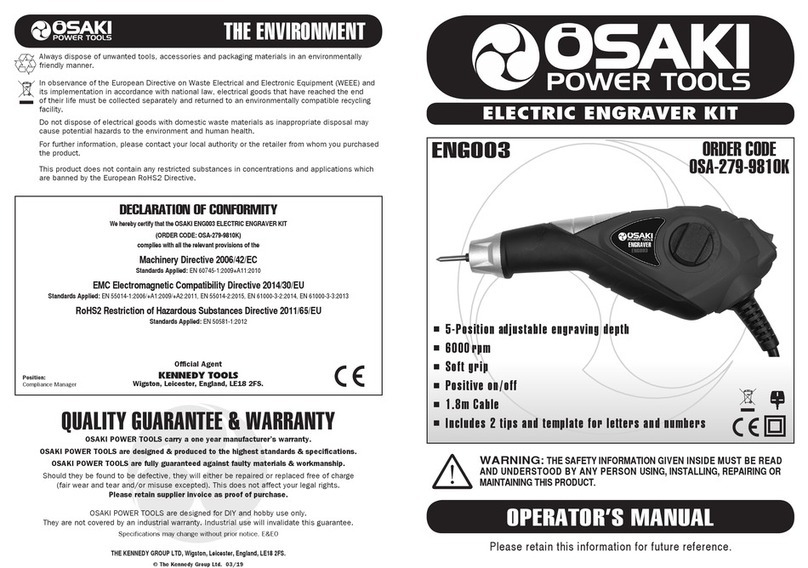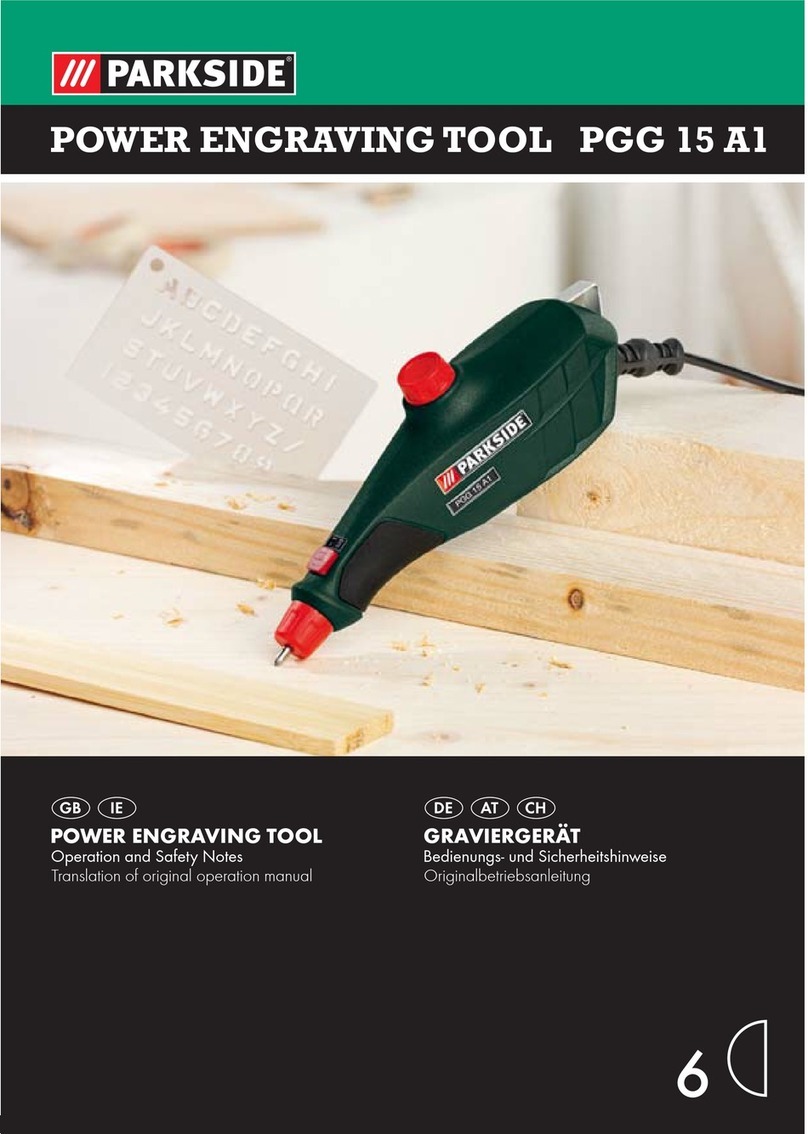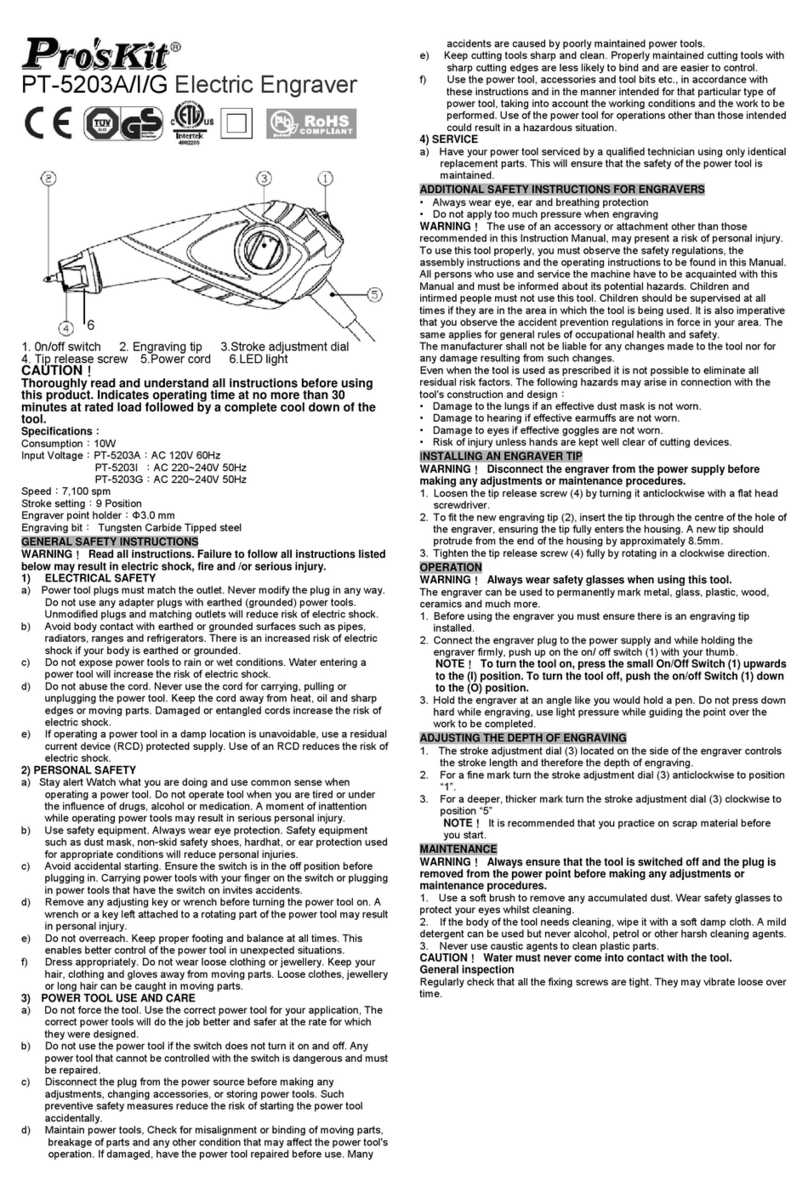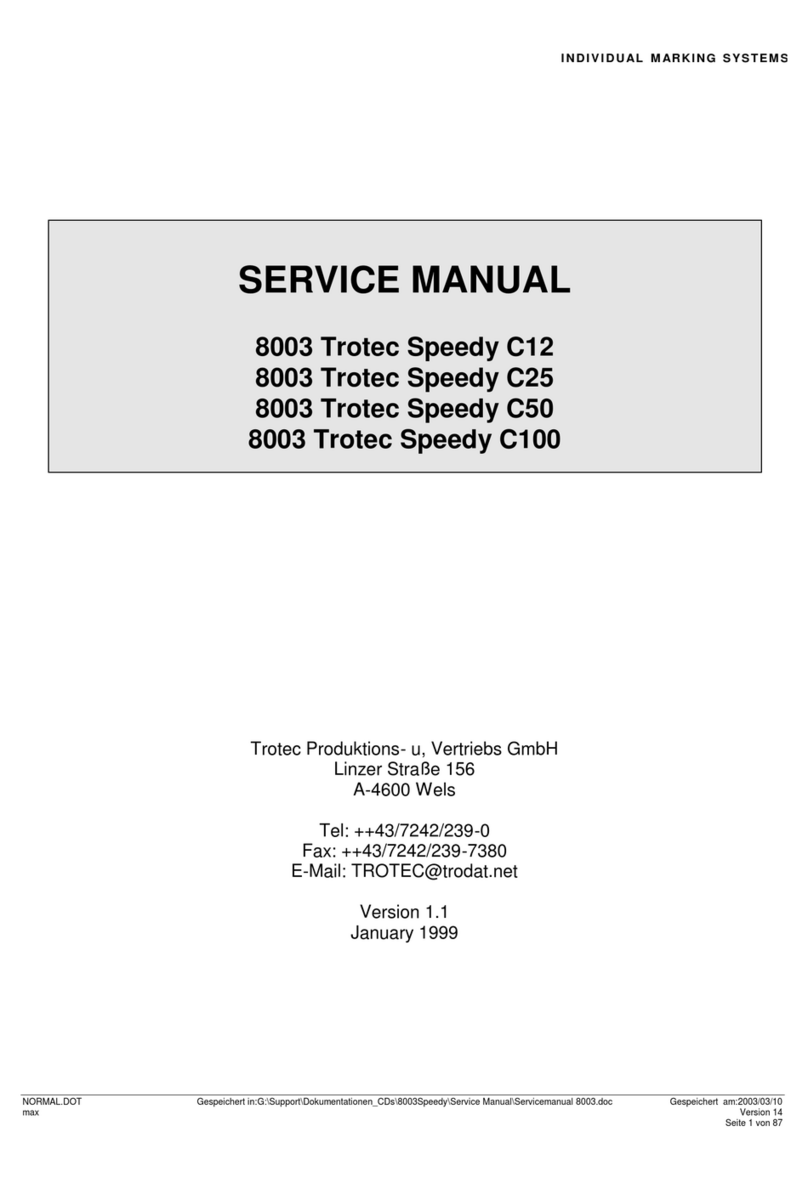Epilog Fusion13000 User manual

OWNER'S MANUAL FOR EPILOG
Fusion - MODEL 13000
This manual can also be found in electronic format on the
Epilog Dashboard Drivers and Documentation
disk that came with your laser system.
April 17, 2013
16371 Table Mountain Parkway
Golden, CO 80403
Phone (303) 277-1188
Fax (303) 277-9669
Technical Support Direct Line: (303) 215-9171
Technical Support Online:
www.epiloglaser.com/service.htm
www.epiloglaser.com/downloads.htm

ii
THIS PAGE WAS
INTENTIONALLY LEFT BLANK

Contents at a Glance
iii
Fire Warning!.........................................................................................i
Introduction ........................................................................................ xi
Epilog Laser Setup...............................................................................1
Section 1: Safety ............................................................................................................................ 1
Section 2: Dos and Don’ts ........................................................................................................... 13
Section 3: Getting Started .............................................................................................................. 1
Section 4: Installing the ECC (Epilog Control Center) ............................................................... 12
Section 5: Installing the Epilog Dashboard Print Driver ............................................................. 22
Section 6: Using the Epilog Dashboard ....................................................................................... 47
Basic Operations................................................................................79
Section 7: Quick Start & Easy Setup ........................................................................................... 81
Section 8: Using the Front Control Panel .................................................................................... 91
Section 9: Using the ECC (Epilog Control Center).................................................................... 101
Section 10: Standard & Optional Machine Features.................................................................. 107
Section 11: Engraving Machine Cleaning ................................................................................. 119
Section 12: Speed and Power Recommendations...................................................................... 131
Section 13: Material Engraving Techniques.............................................................................. 139
Section 14: Material Suppliers................................................................................................... 155
Technical Support, Troubleshooting and Specifications...................161
Section 15: In Case of Difficulty ............................................................................................... 163
Section 16: Specifications.......................................................................................................... 165
Section 17: Upgrading the Operational Firmware..................................................................... 171
APPENDIX A WARRANTY STATEMENT ...............................................177
APPENDIX B PRINTING FROM AUTOCAD...........................................179
APPENDIX C ADDITIONAL DASHBOARD PRINT DRIVER INSTRUCTIONS
........................................................................................................183
INDEX...............................................................................................195

Contents at a Glance
iv
THIS PAGE WAS
INTENTIONALLY LEFT BLANK

Table of Contents
v
Fire Warning!.........................................................................................i
Introduction ........................................................................................ xi
How to Use This Owner’s Manual ........................................................................................ xi
Epilog Laser Setup...............................................................................1
Section 1: Safety ............................................................................................................................ 1
Laser Safety ............................................................................................................................ 1
Electrical Safety ...................................................................................................................... 3
Fire Safety............................................................................................................................... 4
Safety Features and Regulatory Compliance.......................................................................... 5
Section 2: Dos and Don’ts ........................................................................................................... 13
DON’T!................................................................................................................................. 13
DO......................................................................................................................................... 14
Section 3: Getting Started .............................................................................................................. 1
Setting Up Your Laser System ............................................................................................... 1
Connecting the Exhaust ..........................................................................................................7
Connecting Electrical Power................................................................................................... 9
Section 4: Installing the ECC (Epilog Control Center) ............................................................... 12
USB Port ............................................................................................................................... 17
Ethernet Port ......................................................................................................................... 17
Section 5: Installing the Epilog Dashboard Print Driver ............................................................. 22
Installing the Dashboard Driver Using the USB Connection using XP or Vista.................. 23
Installing the Dashboard Driver Using the USB Connection using Windows 7 or 8........... 23
Installing the Dashboard Driver Using an Ethernet Connection and a Crossover Cable ..... 33
Section 6: Using the Epilog Dashboard ....................................................................................... 47
Additional Dashboard Driver Features ................................................................................. 75
Changing Dashboard Driver Defaults................................................................................... 77

Table of Contents
vi
Basic Operations................................................................................79
Section 7: Quick Start & Easy Setup ........................................................................................... 81
Artwork Setup....................................................................................................................... 81
Job Setup............................................................................................................................... 84
Section 8: Using the Front Control Panel .................................................................................... 91
Section 9: Using the ECC (Epilog Control Center).................................................................... 101
Job Tab................................................................................................................................ 101
Configuration Tab............................................................................................................... 105
Section 10: Standard & Optional Machine Features.................................................................. 107
Air Assist ............................................................................................................................ 107
Front Access Door .............................................................................................................. 108
Task Plate............................................................................................................................ 109
Optional Vector Grid/Vacuum Hold-down Table .............................................................. 109
Pin Table ............................................................................................................................. 113
Section 11: Engraving Machine Cleaning ................................................................................. 119
This cleaning section may show photos of other Epilog machines. The cleaning process is
the same so please use these photos as a reference guide................................................... 119
Cleaning - Important!............................................................................................................... i
Fire Warning!...................................................................................................................... 119
Laser Tube .......................................................................................................................... 129
Section 12: Speed and Power Recommendations...................................................................... 131
Engraving Speed ................................................................................................................. 131
Engraving Power................................................................................................................. 131
Recommendations............................................................................................................... 132
Multiple Passes ................................................................................................................... 133
30 Watt................................................................................................................................ 134
40 Watt................................................................................................................................ 135
50 Watt................................................................................................................................ 136
60 Watt................................................................................................................................ 137
75 Watt................................................................................................................................ 138

Table of Contents
vii
Section 13: Material Engraving Techniques.............................................................................. 139
Acrylic...................................................................................................................................... i
Fire Warning!...................................................................................................................... 139
Anodized Aluminum........................................................................................................... 142
Brass - Painted .................................................................................................................... 142
Glass.................................................................................................................................... 144
Notary Seals - Delrin .......................................................................................................... 146
Plastic.................................................................................................................................. 147
Rubber Stamps .................................................................................................................... 149
Wood................................................................................................................................... 149
Section 14: Material Suppliers................................................................................................... 155
Technical Support, Troubleshooting and Specifications...................161
Section 15: In Case of Difficulty ............................................................................................... 163
Contacting Technical Support............................................................................................. 163
Section 16: Specifications.......................................................................................................... 165
Epilog Fusion 32 x 20 Specifications ................................................................................. 165
Compatibility ...................................................................................................................... 166
Recommended PC............................................................................................................... 166
Other Computer Hardware Recommendations................................................................... 168
About The Laser ................................................................................................................. 168
Federal Communications Commission (FCC) Notice ........................................................ 169
Section 17: Upgrading the Operational Firmware..................................................................... 171
Upgrading Your Firmware.................................................................................................. 171
Installing New Firmware onto Your Computer .................................................................. 172
Transferring New Firmware from Your Computer to Your Laser ..................................... 174
APPENDIX A WARRANTY STATEMENT ...............................................177
APPENDIX B PRINTING FROM AUTOCAD...........................................179
APPENDIX C ADDITIONAL DASHBOARD PRINT DRIVER INSTRUCTIONS
........................................................................................................183
Windows 7: Setting up the TCP/IP Address in the Computer........................................... 183
Windows 8: Installing the 64-bit Epilog Dashboard Print Driver in Windows 8.............. 189

Table of Contents
viii
INDEX...............................................................................................195
THIS PAGE WAS
INTENTIONALLY LEFT BLANK

ix
Fire Warning!
Your laser system uses a high intensity beam of light that can generate extremely
high temperatures when it comes into contact with the material being engraved,
marked or cut. Some materials are extremely flammable and can easily ignite and
burst into open flame setting the machine afire. This open flame is very
dangerous and has the potential to destroy not only the machine, but the building
in which it is housed.
Experience shows that vector cutting with the laser has the most potential to
create an open flame. Many materials are susceptible to igniting, but acrylic, in
all its different forms, has been shown to be especially flammable when vector
cutting with the laser.
Please read the following warnings and recommendations and follow them closely
at all times!
NEVER let the laser system operate if it will be unattended.
KEEP the area around the machine clean and free of clutter, combustible
materials, explosives, or volatile solvents such as acetone, alcohol, or
gasoline.
ALWAYS keep a properly maintained and inspected fire extinguisher on
hand. Epilog recommends a Halotron fire extinguisher or a multi-purpose
dry chemical fire extinguisher. The Halotron extinguishers are more
expensive than a dry chemical, but offer certain advantages should you
ever need to use an extinguisher. The Halotron extinguisher discharges a
clean, easily removable substance that is not harmful to the mechanics or
wiring of the laser system. The dry chemical extinguisher discharges a
sticky, corrosive powder that is very difficult to clean up.
ALWAYS use air assist when vector cutting.
BE CAREFUL! when vector cutting. Many materials have the potential
to burst suddenly into flames – even materials that may be very familiar to
the user. Always monitor the machine when it is operating.
KEEP YOUR LASER SYSTEM CLEAN – A build up of cutting and
engraving reside and debris is dangerous and can create a fire hazard in its
own right. Keep your laser system clean and free of debris. Regularly
remove the vector grid to clean any small pieces that have fallen through
the grid.

Fire Warning!
x
SEE PREVIOUS PAGE

xi
Introduction
How to Use This Owner’s Manual
Thank you for purchasing an Epilog Fusion Laser System. Your Epilog system
has been designed to be easy to operate, but you will utilize it to its fullest
potential by taking some time to read this owner’s manual prior to use. You will
be ready to use the Epilog laser system as soon as you read the first six sections.
Then you can refer to topics in the remaining sections, as you work.
Structure of the Manual
Part I: Setup
Sections 1 through 6 explain how to uncrate and set up your Epilog system,
important safety information you need to know before you use it, the Do’s and
Don’ts of operating the laser, configuring your computer to run the Epilog
Dashboard print driver, configuring CorelDraw, and a brief user’s guide to
running your first job.
Part II: Basic Operations
Sections 7 through 14 explain Using the Epilog Dashboard Print Driver, basic
Epilog laser operations and maintenance, machine features, speed and power
recommendations, material engraving techniques, and material suppliers.
Part III: Troubleshooting, Service and Specifications
Sections 15 through 17 assist with problem troubleshooting, service information;
system specifications and firmware upgrade instructions.
APPENDIX A
Epilog Warranty Information.
APPENDIX B
Printing from AutoCAD.
APPENDIX C
Additional Dashboard Print Driver Instructions.
INDEX

Introduction
xii
Icons Used in this Manual
Look for these symbols to help you find valuable information throughout the text:
Sometimes the right perspective on a procedure is essential to success. This icon
Flags a Quick Note regarding the task at hand.
This Icon signifies places to look for additional information to assist with the
topic currently being discussed.
This Icon highlights current contact information for receiving help.
This Icon signifies advice you can try out with your machine right away.
This Icon signifies advice you can try that will save you significant time.
Running into trouble can be detrimental to your success so we’ve marked
Warnings and Cautions with this Icon.
Indicates pages including information regarding connecting your laser system to
your computer using an USB connection.

Introduction
xiii
Indicates pages including information regarding connecting your laser system to
your computer using an Ethernet connection.
Indicates the potential for fire danger when operating the laser.

Introduction
xiv
THIS PAGE WAS
INTENTIONALLY LEFT BLANK

1
Manual
Epilog Laser Setup

2
THIS PAGE WAS
INTENTIONALLY LEFT BLANK

1
Section 1: Safety
In This Section
Laser Safety
Electrical Safety
Fire Safety
Safety Features And Regulatory Compliance
Laser Safety
The Epilog Model 13000 Laser System is a Class 2 laser product, as defined in
International Standard IEC 60825-1.
The Epilog Model 13000 complies with 21 CFR 1040.10 and 1040.11, the
Federal Performance Standards for Light-Emitting Products, except for deviations
pursuant to Laser Notice No. 50, dated July 16, 2001. The Center for Devices and
Radiological Health, of the US FDA, issued Laser Notice No. 50 to permit
manufacturers to classify and manufacture their products in accordance with the
International Standard.
The output of the embedded high-power CO2engraving laser is fully contained.
The laser cabinet has safety interlocks that turn the laser off if the door is opened
during operation, and no special precautions are necessary to operate the high-
power laser safely. However, the visible output beam of the Laser Diode Pointer
(Red Dot Pointer) is accessible to the operator. While this device employs the
same technology as the familiar laser pen-pointers, like them it is potentially
hazardous if its beam is directed into the eye.
We have made every effort to make the Laser Diode Pointer (Red Dot Pointer) as
safe as possible. Its beam path is located well inside the cabinet, and under
normal conditions, no hazardous levels of laser radiation can escape.

Section 1: Safety
2
The operator of the Epilog Model 13000 should observe the following general
precautions:
DO NOT disassemble the machine or remove any of its protective covers
while the unit is plugged in.
DO NOT attempt to defeat the door interlocks.
DO NOT view directly into the beam of the Laser Diode Pointer (Red Dot
Pointer).
DO NOT operate the Laser Diode Pointer (Red Dot Pointer) without the
machine’s focus lens in place. If the unfocused beam strikes a reflective
surface, it could be directed out of the cabinet.
Caution – Use of controls or adjustments or performance of procedures other than
those specified herein may result in hazardous radiation exposure.
* * *
The standard reference for laser safety is the American Standard for the Safe Use
of Lasers, Z136.1-2000, developed by the American National Standards Institute
(ANSI). This reference is the basis for many of the federal regulations for laser
and laser system manufacturers, and for the Occupational Safety and Health
Administration (OSHA) laser safety guidelines. It contains detailed information
concerning proper installation and use of laser systems.
While the ANSI standard itself does not have the force of law, its
recommendations, including warning signage, training, and the designation of a
laser safety officer, may be compulsory under local workplace regulations when
operating laser systems above Class I. It is the operator’s responsibility to ensure
that the installation and operation of the Epilog Model 13000 Laser System is
performed in accordance with all applicable laws.
Copies of ANSI Standard Z136.1-2000 are available from Epilog Corporation or
from:
Laser Institute of America
12424 Research Parkway, Suite 125
Orlando, FL 32826
(407) 380-1553

Section 1: Safety
3
Electrical Safety
The AC input power to the Epilog Model 13000 Laser System is potentially lethal
and is fully contained within the cabinet.
DO NOT open any of the machine’s access panels while the unit is
plugged in. Opening a panel may expose the operator to the unit’s AC
input power.
DO NOT make or break any electrical connections to the system while the
unit is turned on.

Section 1: Safety
4
Fire Safety
Laser cutting and engraving systems represent a significant fire hazard. Most
engraving materials are inherently combustible, and while the objective of most
cutting and engraving operations is to vaporize material without burning, it is easy
to ignite a flame. Usually this is a simple “flare” of burning gases, issuing from
the focused spot on the work piece, which follows the moving spot and which
extinguishes itself as soon as the laser beam is modulated off. But should the
work piece actually be set on fire, the fire must be extinguished by the operator at
once, or the machine will be seriously damaged or destroyed!
Experience shows that vector cutting with the laser has the most potential to
create an open flame. Many materials are susceptible to igniting, but acrylic, in
all its different forms, has been shown to be especially flammable when vector
cutting with the laser.
Please read the following warnings and recommendations and follow them closely
at all times!
NEVER let the laser system operate if it will be unattended.
KEEP the area around the machine clean and free of unnecessary clutter,
combustible materials, explosives, or volatile solvents such as acetone,
alcohol, or gasoline.
ALWAYS keep a properly maintained and inspected fire extinguisher on
hand. Epilog recommends a Halotron fire extinguisher or a multi-purpose
dry chemical fire extinguisher. The Halotron extinguishers are more
expensive than a dry chemical, but offer certain advantages should you
ever need to use an extinguisher. The Halotron extinguisher discharges a
clean, easily removable substance that is not harmful to the mechanics or
wiring of the laser system. The dry chemical extinguisher discharges a
sticky, corrosive powder that is very difficult to clean up.
ALWAYS use air assist when vector cutting.
BE CAREFUL! When vector cutting. Many materials have the potential
to burst suddenly into flames – even materials that may be very familiar to
the user. Always monitor the machine when it is operating.
KEEP YOUR LASER SYSTEM CLEAN – A build up of cutting and
engraving reside and debris is dangerous and can create a fire hazard in its
own right. Keep your laser system clean and free of debris. Regularly
remove the vector grid to clean any small pieces that have fallen through
the grid.
This manual suits for next models
1
Table of contents
Other Epilog Engraver manuals
